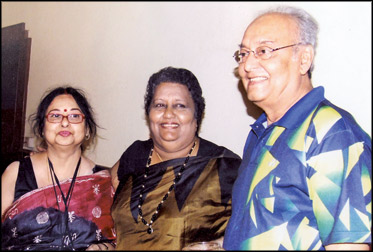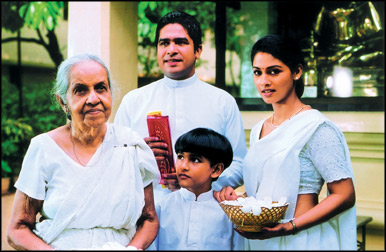|
Exploring the infinite nature of mankind:
Genuine art stands test of time
|

Sumithra Peries at Kolkata Film Festival with Soumitra Chatterji
and Madhavi Mukharjee who acted in Satyajit Ray’s films.
|
Being a terrific filmmaker, Sumithra Peries,
though she is always in the shadow of her legendary filmmaker husband
Dr. Lester James Peries, has cast her larger than life shadow on the Sri
Lankan filmdom as a pioneer female filmmaker.
Rather than taking characters out of the
book, Sumithra opted to take strong and complex female characters who
dominated her films, out of life and out of the milieu. They are full of
flesh and blood as in the `Yahalu Yeheli', `Sagara Jalaya' and `Yahaluwo'.
Though well grounded on the native soil, they stand tall as characters
embodying universal human qualities, at times transcending cultural,
linguistic and geographical boundaries. It is because of this universal
quality and the depiction of complex characters that films by Sumithra
Peries are of lasting value and are part of the collective legacy of the
nation.
In her latest film 'Yahaluwo' which won
diverse accolades at international film festivals including the SAARC
Film Festival, Sumithra explores the complex web of ethnicity-based
relationships of persons of different social strata. Though the action
takes place in a household, the film epitomises complex micro-macro
relationships of a population in a multi-ethnic and multi-lingual
polity. The minute conflict enunciated in the film is universally
applicable to not only traditionally multi-ethnic and multi-lingual
countries, but also to societies increasingly becoming multi-ethnic and
multi-lingual in nature.
by Ranga CHANDRARATHNE
Q: You are credited with being one of the pioneering woman filmmakers
who had discussed gender issues, perhaps, for the first time in Sri
Lankan Cinema. In retrospective of a trails blazing career in cinema,
how do you revisit the days when you stepped into the then
male-dominated cinema and what were the initial stumbling blocks that
you had to encounter in your journey?

Yahaluwo which won international acclaim, has not been
recognised by some of Sri Lankan critics for reasons best known
to them. |

‘Nidhanaya’ is a classic example of Sri Lanka’s inability to
preserve its artistic legacy. The original print of `Nidhanaya’
was destroyed as a result of Vinegar syndrome. Had Sri Lanka
possessed a film archive, it could have well been preserved. |

A scene from ‘Beddegama’ |
A: Firstly, I never considered my films to be issue related. They
were essentially woman centric.
The central character being a woman or girl of the films naturally
depicted her in difficult, social or emotional situations and how she
overcame or did not overcome them*.
Q: Can you discuss some of the prominent gender issues that you have
focused on, in your films within the context of Sri Lankan society?
A: When I look back I feel that more than the male-dominated cinema
it was the commercial formula film that was a stumbling block, to me as
a filmmaker then as it is now, not being issue related. My films
depicted my central female character within the framework of the
narrative with honesty and sincerity - whatever criticism of the social
forces at play were implicit and not explicit.
Q: It has been established over the years that cinema is a closer
medium to public than literature. Since Dr. Lester James Peries
pioneered in taking Gamperaliya, as a work of art, beyond our shores and
English translation of the novel "Gamperaliya" has already been
published, how do you consider cinema as a repository of collective
experiences of a nation against literature?
A: Cinema being primarily a visual medium it is certainly more
accessible to the public than literature. Even as a repository of the
collective experiences of a nation the audio visual image locks within
its frames, the sight and sounds of a given place at a given time to be
read and deciphered without ambiguity by later generations.
Q: The salient feature of a masterpiece is its universal feel across
geographical and cultural boundaries. Even with their cultural baggages,
these masterpieces translate profound human experience into collective
legacy of the mankind. Before the original masterpiece in Sinhala is
translated into English or any other language, you have rendered them
into cinema. Both Dr. Lester James Peries' and your works are
subsequently sub-titled in other languages such as English, French, and
German etc. How important, do you think, in preserving them?
A: Films that embody profound human experiences cross cultural
boundaries, to be read and understood by other cultures with minimum
help of subtitles. Film being a perishable medium it is imperative that
they be preserved, firstly, in its original form and if not in digital
or any other medium that may be available.
Q: Television channels like Lak Roo have taken steps to preserve the
cinematic legacy of Sri Lanka. What are your views on such attempts in
general and rendering cinema into another media such as television, VCD
or DVD in particular?
A: Benevolent channels like Lak Roo coming forward to render films
made on a perishable medium like celluloid to another medium is a
felicitous sign.
Q: Compared with your era, cinema has developed in terms of
technology and language of cinema. However, it seems that a handful of
filmmakers have made use of technology and highly evolved language of
cinema.
A: Unfortunately, cinematic diction has not been satisfactorily
evolved in Sri Lankan cinema.
Q: Except certain instances; it has not developed beyond story
telling. What do you think are the root causes for this situation?
A: I believe that from the silent, era the language of cinema as
introduced by D. W. Griffith has not changed. The syntax and grammar of
cinema has remained the same - what technology has added is a
superficial gloss in terms of picture and sound which I believe has not
enhanced the artistic quality of film. The storytelling and pacing of
our films are reflective of the social milieu in which they are set.
Q: In the "Yahaluwo", you have deviated from your practice of
exploring gender issues, and venture into a different area. Although the
country has suffered from a protracted conflict, a small number of
filmmakers have explored the theme of ethnic harmony and racial
reconciliation. Why do you think Sri Lankan filmmakers in general have
shunned themselves from this harsh reality and enjoyed the comfort in
their cocoons? What is the role of a filmmaker particularly in the
context of a conflict-ridden society?
A: I don't expect a filmmaker to be a didactic preacher or social
reformer.
As an honest artiste he would take the sum total of his experience
and translate it into a work of art that would communicate a meaningful
experience to his audience.
His attitudes and feelings would be reflected in his world. The real
experience of the artiste would be told to us in the future by those who
actually experienced it but not as a second hand emissary.
Q: Sri Lankan cinema lacks both women filmmakers and artistic
filmmakers. Although the socio-economic conditions have improved over
the years, Sri Lankan woman has not yet been liberated from her
conventional role ascribed to her. After you, there are only a few women
filmmakers who have entered the cinema. What are the contributory
factors, you think, for this situation?
A: Even world cinema took a long time to give some space to women
filmmakers - Sri Lanka is no better. Now when the Sri Lankan film
industry is gasping for survival, naturally the first casualty would be
the women filmmakers.
Q: Looking back on the 50 years of Sri Lankan cinema, it is
increasingly clear that contemporary Sri Lankan cinema has failed, by
and large, to reflect the milieu and to discuss the complex
socio-economic issues. While some filmmakers are attempting to paint a
hell-like picture of Sri Lanka purportedly aimed at securing awards at
international film festivals, some others are engaged in re-creation of
the country's fractured history in search of an ethno-linguistic
supremacy. In this context, how do you analyse this situation?
A: The mainstream Sri Lankan cinema, like any other cinema in the
world is entertainment oriented.
The space left for a committed filmmaker to explore genuine
experiences is very small in this context. Filmmakers find small niche
markets abroad to sustain their films and film festivals give a window
to showcase their films.
A genuine artiste should feel free to express his concerns about his
country if his concerns are genuine and is not working to the agenda of
other destabling forces.
Q: Though we have celebrated 60 years of Sri Lankan cinema, we still
don't have a fully - fledged film archive or have not introduced cinema
as a subject in a broader perspective and also we have not been able to
set up an institution dedicated to teaching and researching on cinema.
What are your suggestions for creating a vibrant cinema culture in Sri
Lanka?
A: An archive is a prerequisite for any film culture. Without
preservation the future generation will have no access to the history of
cinema.
The media, whether written, audio visual, can stimulate and educate
the younger generation by showing films in any format of artistic and
historical value and shape young minds to read films with greater
insight and understanding to enrich themselves.
*********
Sumithra on Lak Roo TV
According to Sumithra Peries, Lak Roo Television channel run by the
Government Film Unit (GFU) has taken up the task of preserving the
artistic films for posterity through the electronic media. It has
tremendously improved the accessibility of artistic films such as `Nidhanaya'
to a wider audience. The Government Information Department, together
with Sri Lanka Telecom Affiliate Visioncom, proudly launched "Lak Roo" a
new television channel on the 90th birthday of Sri Lanka cinematic
legend Dr. Lester James Peries. Lak Roo is available exclusively on PEO
TV, a revolutionary new medium of television entertainment that will
feature news, documentaries and special events in relation to Sri Lankan
culture, politics and society derived from the archives of the GFU.
*********
|

